CCSF Campus
Phelan Avenue
Diego Rivera Theater and Conlan Hall
During the second season (1940) of the Golden Gate International Exposition, organizers began the Art in Action program in the Hall of Fine and Decorative Arts. During the 1939 season, the hall had housed the art collections of European and Pacific cultures. The concept was a working art exhibit in which artists of many media, including sculptors, painters, muralists, weavers, stained glass artists, printmakers, potters, and engravers were invited to move their studios into the Hall and create their art while the public watched.
Artists included sculptor Ruth Cravath, mosaic artist Herman Volz, sculptor Frederick Law Olmsted, etchings artist Elizabeth Ginno Winkler, muralist Diego Rivera, and wood carver Dudley C. Carter.

A view of the Hall of Decorative and Fine Arts from the San Francisco Bay. The building served as the Palace of Fine and Decorative Arts during the GGIE and was constructed to serve as one of two hangar buildings built for the San Francisco airport that was planned for the island. (Library of Congress)
This is when Dudley Carter created The Ram. The sculpture, a bighorn mountain ram, was carved in just 30 days from a single redwood log using primitive instruments such as a wood axe.
At the conclusion of the fair, the college architect, Timothy Pfleuger, presented The Ram to Archibald J. Cloud, president emeritus of the college. It was to serve as the symbol of the college mascot.
Timothy Pfleuger was on the GGIE committee, it was his idea for the Art in Action project, and due to his also being the college architect, much of the finished art from Art in Action was always slated to end up at what was then San Francisco Junior College and after the war became City College of San Francisco (CCSF).
For five years The Ram was stored in the men’s gymnasium because of the absence of a place considered appropriate for it. With the acquisition of the west campus The Ram was placed outside, periodically changing locations, and from time to time students would paint it in the campus colors of red and white. Sometimes rival schools would repaint The Ram in their own school colors. In spring of 1983, The Ram was restored by Carter (who was by then 90 years old) with the use of a pickaxe and its original, natural redwood.
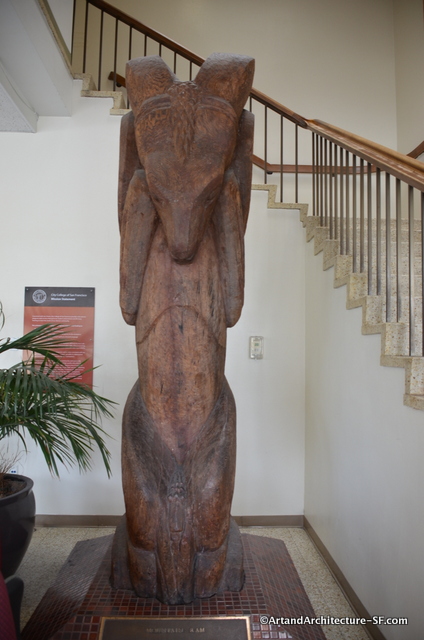
The Ram by Dudley C. Carver was originally carved at the GGIE and now stands in Conlan Hall at CCSF
The Goddess of the Forest is another redwood sculpture created by Carter during the GGIE. It was originally 26 feet tall, and had a girth at the base of 21 feet, for many years this piece was located in Golden Gate Park. The sculpture suffered extensive water damage to the lower half before being restored by CCSF Art Department instructor Roger Baird in 1992. It is now only 15 feet tall and stands facing the Diego Rivera mural in the Diego Rivera Theater.
It almost did not make it to CCSF. Difficulties arose in regards to paying for the statue’s move from Golden Gate Park when, then CCSF President Carlos B.Ramirez, decided that the estimated $8,000 moving fee was too high.
The actual moving fee was $3,000 and eventually paid for out of the Student Union’s budget.
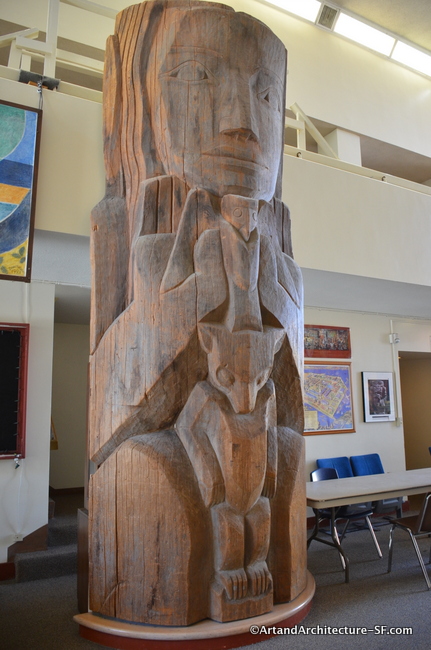
Goddess of the Forest originally carved by Dudley C. Carter at the GGIE now stands in the Diego Rivera Theater of CCSF
Diego Rivera worked directly across from Carter at the Golden Gate International Exposition and they became friends. Rivera said the following about Carter, “Here in the Fine Arts Building there is a man carving wood. This man was an engineer, an educated and sophisticated man. He lived with the Indians and then he became an artist, and his art for [a while] was like Indian art—only not the same, but a great deal of Indian feeling had passed into him and it came out in his art. Now, what he carves is not Indian anymore, but his own expression—and his own expression now has in it what he has felt and that is right, that is the way art should be. First, the assimilation and then the expression, only why do the artists of this continent think that they should always assimilate the art of Europe. They should go to the other Americans for their enrichment because if they copy Europe it will always be something they cannot feel because after all, they are not Europeans.”
Carter shows up in Rivera’s mural that, while originally painted at the GGIE, was always slated for CCSF.
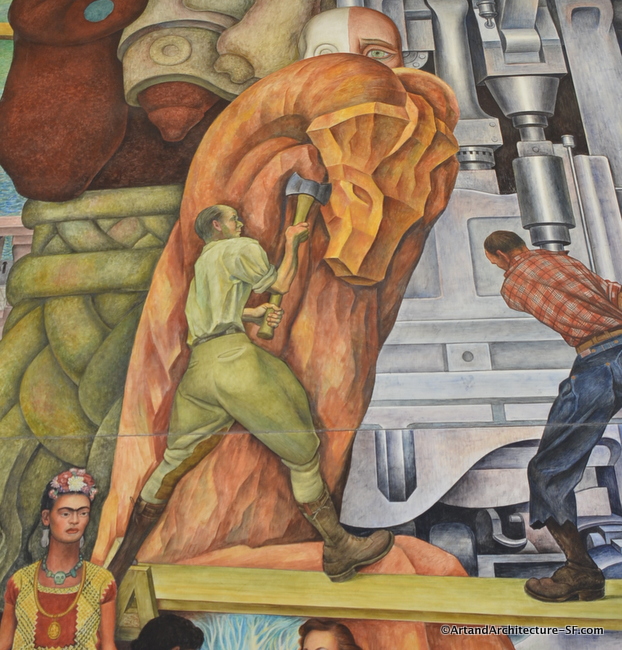
Dudley Carter depicted in Diego Rivera’s mural carving The Ram
The third sculpture by Carter is also in Conlan Hall in the first-floor hallway. This is titled The Beast.
The Beast was actually sculpted by Dudley Carter at Porter College at the University of California in Santa Cruz in 1983. The piece was given to City College by Carter on the urging of the then college president, Carlos Ramirez.

Beast by Dudley C. Carter
Born in New Westminister, Canada on May 6, 1898, Dudley Carter was the son of a woodsman. He was six years old when he began helping out in his father’s lumber camp.
Raised among the totem-carving Kwaquit and Tlingit tribes, he took part in their ceremonies. About 1929, he moved to Seattle where he had art lessons at the Cornish School and studied sculpture at the Art Institute.
Moving to California in the mid-1930s, he lived in San Francisco and worked for the Federal Art Project. He later lived in Carmel where he built houses out of trees that he felled himself. He died in 1992 in Bellevue, Washington.

Carter working on The Ram during the GGIE surrounded by wood chips (Bancroft Library)
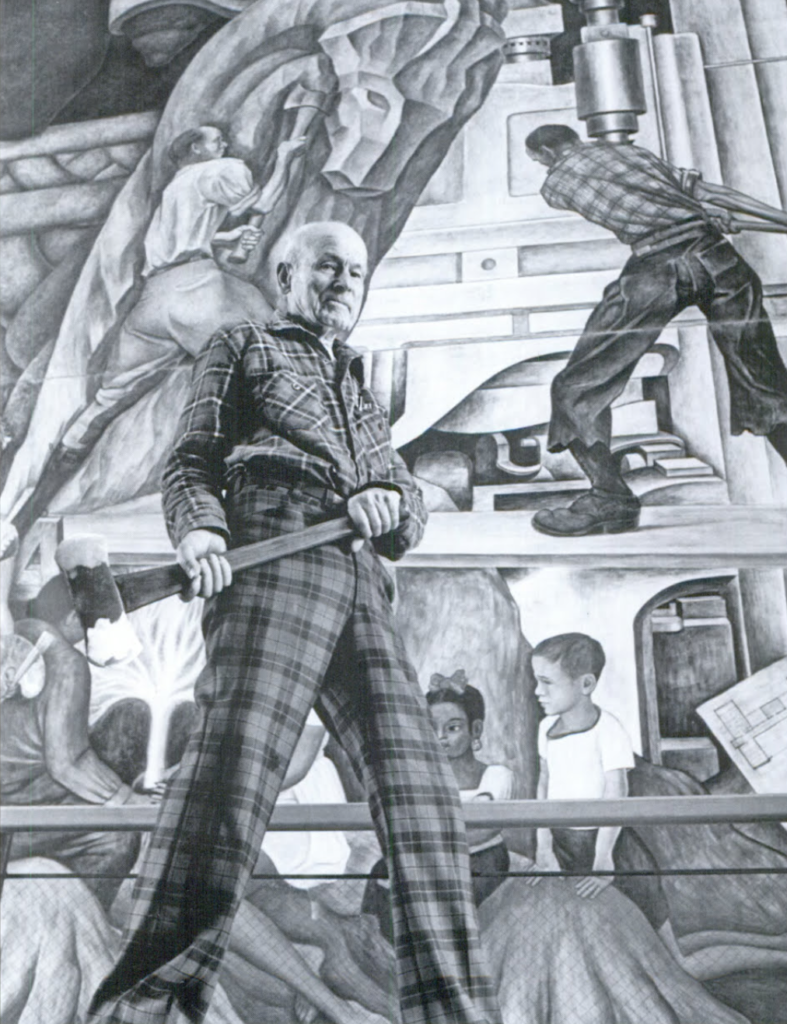
Carter standing with one of his axes in front of his likeness in the Diego Rivera Mural (Bancroft Library)
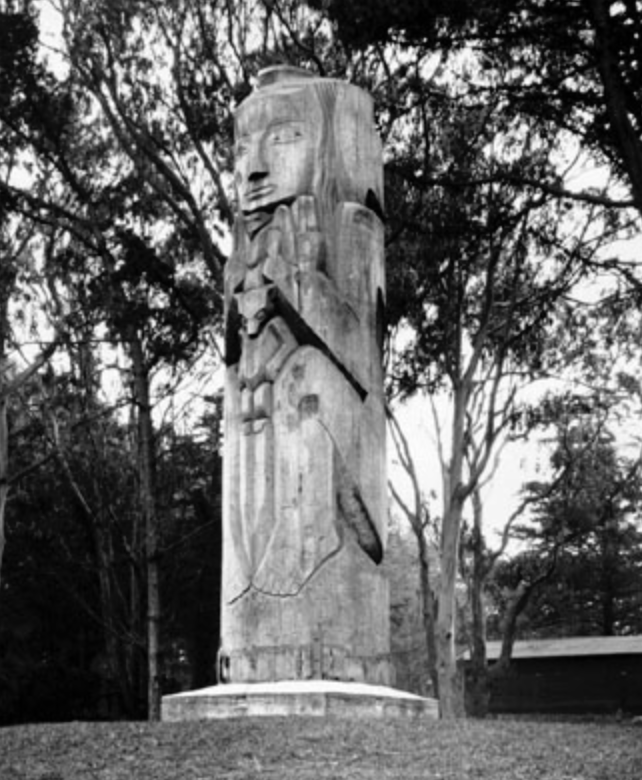
Goddess of the Forest in Golden Gate Park 1951 (SFPL) – Notice the lower portion of the goddess’s legs are still intact. The sculpture now ends just below the feet of the small animal at her knees.